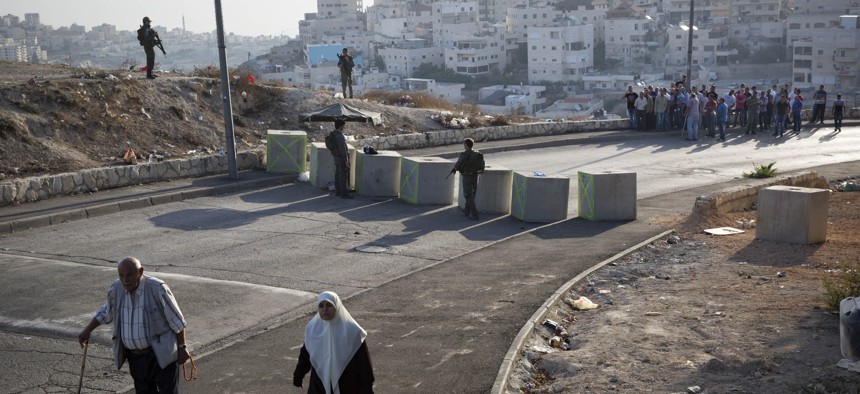
Israeli border police check Palestinian's IDs at a checkpoint as they exit the Arab neighborhood of Issawiyeh in Jerusalem, Sunday, Oct. 18, 2015. AP Photo/Oded Balilty
A Spate of Violence in Israel, and Then What?
The uptick in tensions between Israelis and Palestinians show that neither the one-state nor two-state solutions are viable.
In December 1987 the first intifada began after a traffic accident involving an Israeli truck and a Palestinian pedestrian outside the Jabaliya refugee camp set off a wave of demonstrations against Israel’s occupation of the West Bank and the Gaza Strip. The sudden volleys of rocks pelting Israeli soldiers and the tear gas and rubber bullets in response changed the complexion of the conflict between Israelis and Palestinians almost overnight, likely forever. The mighty Israeli Defense Forces (IDF) were not traversing the Sinai Peninsula in three days, rescuing hostages in Entebbe, or spending two daring minutes over Baghdad, but breaking teenagers’ bones on the streets of Nablus, Hebron, Ramallah, and Gaza City. David had become Goliath and had no answer for Daoud’s slingshot. The Israelis must have been rattled by the images on television and pictures published in the press because, a few months after it all began, the Israeli consul general started doing the rounds of universities and colleges in the New York area to provide Jerusalem’s perspective on the unrest. I remember attending one such event on a chilly evening in a half-empty room at Vassar’s College Center. During the Q&A a member of the audience recalled an encounter with someone he identified as an “Arab friend in Israel.” He alleged that during a debate over politics his friend relayed that, despite their relationship, he would kill him if and when communal violence erupted. It was an odd non sequitur to what had, until that moment, been an interesting discussion thankfully lacking the overwrought theatrics of more recent conversations about the Israeli-Palestinian conflict on America’s campuses.
I bring all this up because the memory came rushing back to me last week when I watched the surveillance footage of a knife-wielding employee of the Israeli phone company, Bezeq, hack a rabbi to death at a bus stop in Jerusalem. It was simply gruesome. There have been all kinds of arguments advanced for this sudden spate of violence, but it actually does not require any kind of deep explanation when the cause is so clear—Palestinian political and religious figures have directly and indirectly exhorted their people to kill Jews and a small number have obliged.
By all accounts daily life has become extraordinarily frightening for Israelis, especially since there does not seem to be an effective answer to random knife-wielding people bent on death. Can the Israelis cordon off East Jerusalem forever? What about Tel Aviv? The bus station in Afula? Do you surround Umm al-Fahm and not let people leave? What about Haifa with its large Palestinian population? It is a mind-boggling problem. The violence has, it seems, ushered a new “psychotic”—to use Bret Stephens’s description—phase in the Israeli-Palestinian conflict.
Stephens reserved “psychotic” for Palestinians, but they have not cornered the market on blind hatred, dark interpretations of religion, and uncompromising ideologies. Israelis too have proven themselves capable of horrific, senseless violence lest anyone forget the names Ali Dawabsheh, Shira Banki, or Yitzhak Rabin for that matter. I can already picture my Twitter feed and email inbox filling up with accusations of “moral equivalence.” By this, critics no doubt mean that I am willfully overlooking the fact that Palestinians leaders abet violence and Israeli officials do not or that I fail to recognize that Israeli violence is justified, but Palestinian bloodshed is not. My only answer is this: The conflict between Israelis and Palestinians is always much more complicated than partisans on both sides would desperately like everyone to believe.
It is true that Prime Minister Benjamin Netanyahu has never implored Israelis to kill Palestinians and that he and members of his government denounced the murder of Dawabsheh. Of course, this comes after years of generalized passivity and tolerance—for political reasons—of the settlers and the extremists among them who have desecrated mosques, burned olive groves, and staged armed attacks on Palestinians. I should add that the perpetrators of these acts, like Rabin’s assassin, have often received halachic justification from settler rabbis. It is also true that the current round of Palestinian violence is based on a falsehood. Israel is not trying to alter the status quo on the Temple Mount/Haram al-Sharif. Yet there are apparently a growing number of Israelis who believe that a change in the delicate Israeli-Jordanian-Palestinian arrangements that govern Jerusalem’s holiest site is necessary to accommodate an increased Jewish presence there. And then there are those who want to “liberate the Temple Mount from Arab (Islamic) occupation.”
The Israeli authorities recognize the danger, but politics often has a way of producing outcomes that end up rewarding those who have little interest in peace. The settlers have won the internal Israeli debate over the status of the West Bank. They are never leaving. If I remember correctly, the last time there was an election in Palestine, Hamas won. No one would fairly describe either group as being in the peace camp. What we are seeing now in Israeli streets are the bloody results of a stalemate that empowers extremes. But here is the most depressing aspect of this current episode: All the incentives exist for a flagging Palestinian leadership to hitch their political fortunes to this violence, and on Israel cracking down, as the stabbing victims multiply, providing a pretext for Palestinians to escalate, leaving the Israelis no choice but to respond in kind. Maybe it will not happen in precisely this fashion, but it seems likely that Israelis and Palestinians are in for a prolonged period of violence. This should finally bury the fantasy of the two-state solution, but as Ari Shavit recently noted, it also shatters the equally unreal one-state solution of both the BDSers and Israel’s right, leaving everyone asking: And then what?
NEXT STORY: Trump Is Right About 9/11




